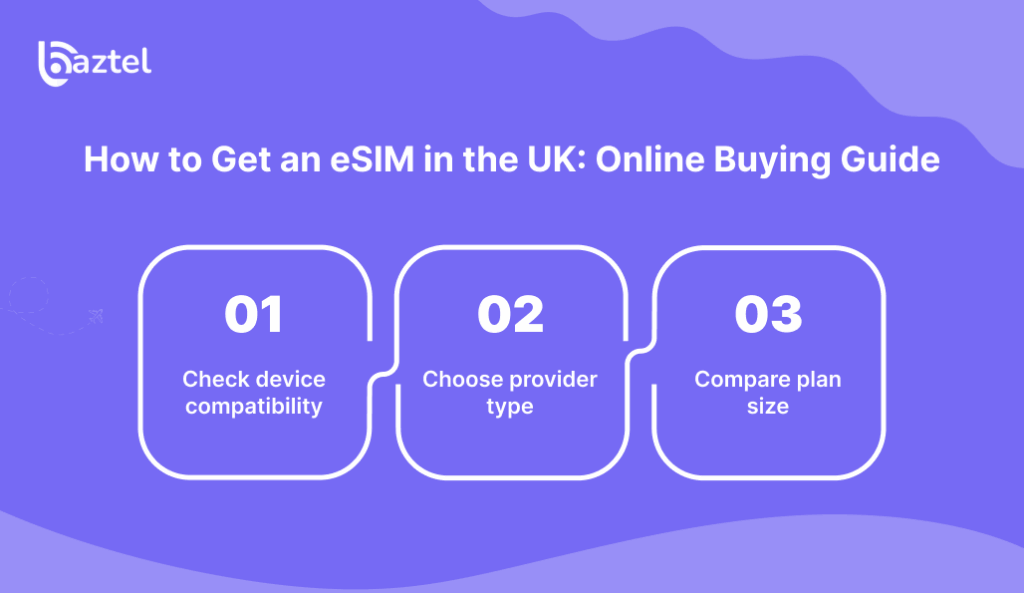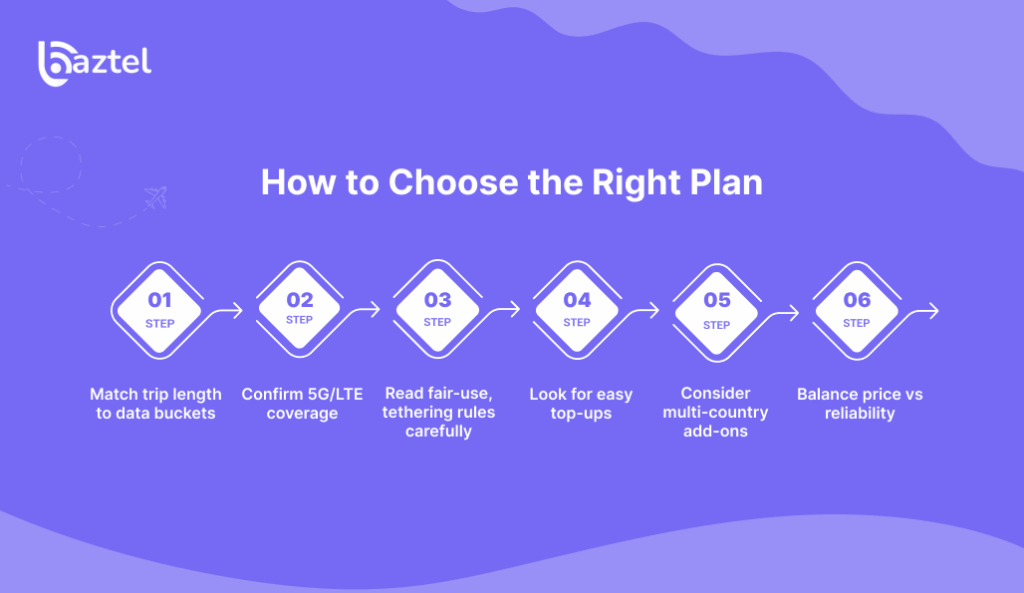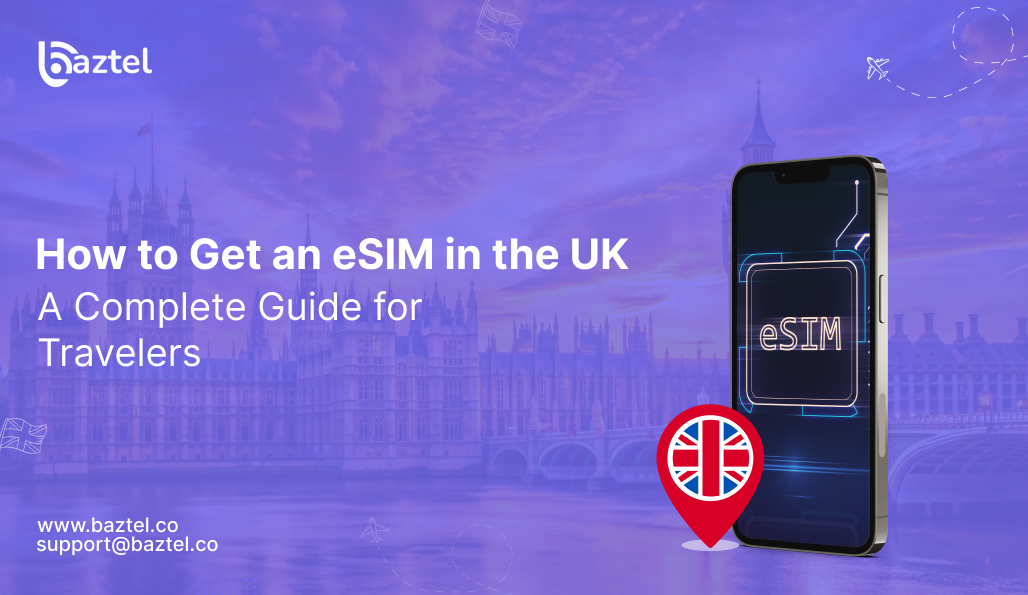Planning a trip or moving to Britain and want data from day one? The United Kingdom is the 7th largest international tourism destination. It is forecasted that the tourism GDP contribution will increase annually by 3% till 2032. An eSIM makes it easy. No store visits, no paper SIM, scan and go. In this guide, you will learn how to get an eSIM in the UK, step by step. We cover phone compatibility, the best ways to buy online, how to activate on iPhone and Android, and how to keep your physical SIM for OTPs. You will also see plan types, costs, and tips for tourists and residents. By the end, you can pick a plan, install it in minutes, and start browsing with confidence.
Why eSIM for Travel?
United Kingdom eSIM for travel keeps your phone connected without hunting for kiosks or swapping tiny cards. You buy a plan online, scan a QR code, and it activates in minutes. No shipping, no waiting. Prices are clear, and you can choose local, regional, or global data packs. New to eSIM? Read Are eSIMs safe?. Keep your physical SIM active for OTPs and bank alerts. Use dual SIM to receive calls on your home number while using local data. Manage everything in your phone settings. Want to video call on the go? Learn how to FaceTime without Wi-Fi using cellular data. Working from a laptop? Here’s how to install an eSIM on a laptop. Top up or switch plans anytime. If a country changes, your plan can change too. It is simple, quick, and reliable for trips. Next, learn how to get an eSIM in the UK with a simple step-by-step: check phone support, choose a plan online, scan the QR, and start using data in minutes.
How to Get an eSIM in the UK: Online Buying Guide

A physical SIM is a tiny plastic card you insert into your phone. An eSIM is a built-in chip that holds a digital plan. Unsure about other unlock tools? Read this quick compare: eSIM vs R-SIM. With a physical SIM, you usually visit a store, pick a card, and swap it when you change numbers or countries. With an eSIM, you buy online, scan a QR code, and activate in minutes. Both connect to the same mobile networks, and many support fast 5G: see eSIM and 5G. eSIMs let you store multiple profiles and use dual SIM, which is great for travel. They are also safer since nothing can be lost or cloned easily. Physical SIMs still help with older phones or quick device swaps, while eSIM needs a supported phone and a transfer process. Need to switch data packs later? Here’s how to change your eSIM plan. Here’s everything you need to know about how to get an eSIM in the UK, from basics to quick activation.
Check device compatibility
First, confirm your phone supports eSIM. Check this eSIM compatibility list. On iPhone, go to Settings, Mobile Service, Add eSIM. On Android, open Settings, Connections or Network, then SIM Manager to see eSIM. Most recent models work, like iPhone XR or newer, Samsung S20 or newer, and Google Pixel 3 or newer. Update your OS, and remove any carrier lock if present. Dual SIM should be available if you plan to keep your physical SIM active for OTPs. If you travel a lot, see how rollouts vary in our guide on eSIM adoption by country. Building connected devices or curious about sensors and wearables. Explore eSIM in IoT. For IT teams and companies planning global fleets, read eSIM for global enterprises. If you still cannot find the option, check the maker’s site for your exact model.
Choose provider type
Pick a provider that fits your trip. UK mobile networks suit residents who want a local number and voice add-ons. Travel eSIM brands focus on data, simple pricing, and easy online setup. Marketplaces list many plans in one place, so you can compare speed, validity, and support. Your home carrier may also sell a UK roaming eSIM, but prices vary. Check hotspot rules, refunds, and top-ups. Activation should be a QR or in-app install. If something fails, try this troubleshooting eSIM guide. Planning ahead, read about the future of eSIM. For teams and frequent work travel, see eSIM for business. Keep it simple, and match this step with your plan for how to get an eSIM in the UK.
Compare plan size
Pick data based on real use, not guesses. Light users who message, use maps, and email can manage with 1 to 3 GB for a short trip. Add reels, photos, and some YouTube, and you may need 5 to 10 GB for a week or two. Long stays or heavy work can push you to 15 to 30 GB. “Unlimited” often has a fair use limit that slows speed later. Check 5G access, hotspot support, and validity days. Choose plans that allow top-ups, set usage alerts, and review basics of eSIM security. Moving off plastic. See how to convert SIM to eSIM. Switching phones on Android. Learn how to transfer an eSIM from one Android to another. Keep your physical SIM for OTPs and bank apps if needed.
How to Choose the Right Plan

Choosing the right eSIM plan is simple when you match it to real needs. Start with trip length, then check coverage, speed, and support. Read fair-use and hotspot rules. See if top-ups are easy and if multi-country add-ons help your route. Compare price with reliability, not just GB. New to eSIM basics. Read is eSIM better than SIM. Moving from plastic. Learn how to transfer SIM to eSIM. Need a QR for setup. Here’s how to get an eSIM QR code. This section ties into how to get an eSIM in the UK by helping you shortlist a plan you can install in minutes, keep your physical SIM for OTPs, and stay online from the airport to your hotel.
Match trip length to data buckets
Pick data for the days you will actually travel. Weekend breaks work with 1 to 3 GB if you mostly use maps and chats. One to two weeks usually need 5 to 10 GB if you post photos and watch short videos. Longer stays or remote work can require 15 GB or more. Avoid “overbuying” large packs that expire. Choose plans that allow top-ups if you run short. While learning how to get an eSIM in the UK, make a simple rule: buy for today, keep the option to add more tomorrow.
Confirm 5G/LTE coverage
Speed depends on the network you use in each city. Check the provider’s coverage map for London, Manchester, Edinburgh, and the smaller towns on your route. 5G is great for uploads and HD calls, but strong LTE is fine for daily use. Read the fine print to see if 5G is included or capped. Look for notes on average speeds, peak hours, and indoor coverage. If you plan train trips, see if tunnels or rural stretches have weaker service. A plan that roams on multiple UK networks often gives steadier data.
Read fair-use, tethering rules carefully
“Unlimited” often has a fair-use limit. After a set GB, speeds may drop for the rest of the day or month. Some plans limit hotspot use or block it fully. Others cap streaming quality. Check daily resets, per-app limits, and any policy on VoIP or Wi-Fi calling. If you must tether a laptop, pick a plan that clearly allows hotspot with enough GB. Save a screenshot of the rules before purchase. This avoids confusion later and helps you claim support if speeds fall below the stated range.
Look for easy top-ups
Top-ups should be quick, in-app, and priced the same as the base plan. You should not need a new QR every time. Prefer accounts that show real-time usage, low-data alerts, and one-tap extensions. Turn off auto top-up if you want full cost control. Check if unused data rolls over. Confirm payment options that work with your card or UPI. Clear receipts and instant reactivation matter when you run out on the move. Simple top-ups beat guessing the perfect data size on day one.
Consider multi-country add-ons
If your route touches Ireland, France, or Schengen stops, a UK plus Europe pack may be cheaper than buying new plans. For cross-border planning, read the ultimate guide to using eSIM plans for international travel. Check the exact list of countries, the GB outside the UK, and any speed or day limits when roaming. If the QR fails or a provider asks for details, see how manual eSIM activation works. Some plans treat EU roaming as a smaller pool within your total data. If you only day-trip once, a short regional add-on can be enough. Still choosing between plastic and digital? Compare physical SIM vs eSIM. For longer rail trips across borders, pick a true regional plan. One plan, one app, fewer surprises.
Balance price vs reliability
Low price is good, but not at the cost of weak support or unstable speeds. Look for providers with clear terms, responsive chat, and real refunds when activation fails. Check reviews that mention city names you will visit, not just generic praise. For route planning, see this guide on eSIMs for travel with country-wise plans and smart tips. Prefer plans that partner with strong UK networks and list expected speed ranges. A slightly higher price for steady 4G or 5G, hotspot allowed, and easy top-ups often saves time and stress. Also compare eSIM vs roaming and eSIM vs pocket WiFi so you pay for the service you need, not only the cheapest GB.
Conclusion
You now know the basics, the checks, and the small details that matter. Start by confirming device support. Check is my phone eSIM compatible. Then pick the right provider and plan size for your dates. Read fair use, hotspot rules, and coverage notes for the cities on your route. Activate on Wi-Fi, save the QR or install in app. On Apple devices, follow this guide on how to activate eSIM on iPhone. Keep your physical SIM on for OTPs. If you switch phones later, see can you transfer an eSIM to another phone. If you are unsure, buy a smaller pack and top up later. This simple path for how to get an eSIM in the UK helps you land, scan, and go online in minutes. Safe travels, and enjoy steady data from the airport to your hotel.
Blog Author
Peter
Peter started BazTel.co to make mobile internet easier for travellers. He noticed how tough it was to find good network options while visiting new countries. That’s when he built BazTel — a place where anyone can buy eSIMs online without confusion or long steps. He believes tech should be simple and useful, not complicated. When he’s free, he likes to travel, test BazTel himself, and keep improving it based on real user problems.

 Botswana
Botswana Zambia
Zambia Congo
Congo Colombia
Colombia China mainland
China mainland Chile
Chile Chad
Chad Central African Republic
Central African Republic Canada
Canada Cameroon
Cameroon Cambodia
Cambodia Burkina Faso
Burkina Faso Bulgaria
Bulgaria Brunei Darussalam
Brunei Darussalam Brazil
Brazil Aland Islands
Aland Islands Bosnia and Herzegovina
Bosnia and Herzegovina Bolivia
Bolivia Belgium
Belgium Belarus
Belarus Bangladesh
Bangladesh Bahrain
Bahrain Azerbaijan
Azerbaijan Austria
Austria Australia
Australia Armenia
Armenia Argentina
Argentina Algeria
Algeria



